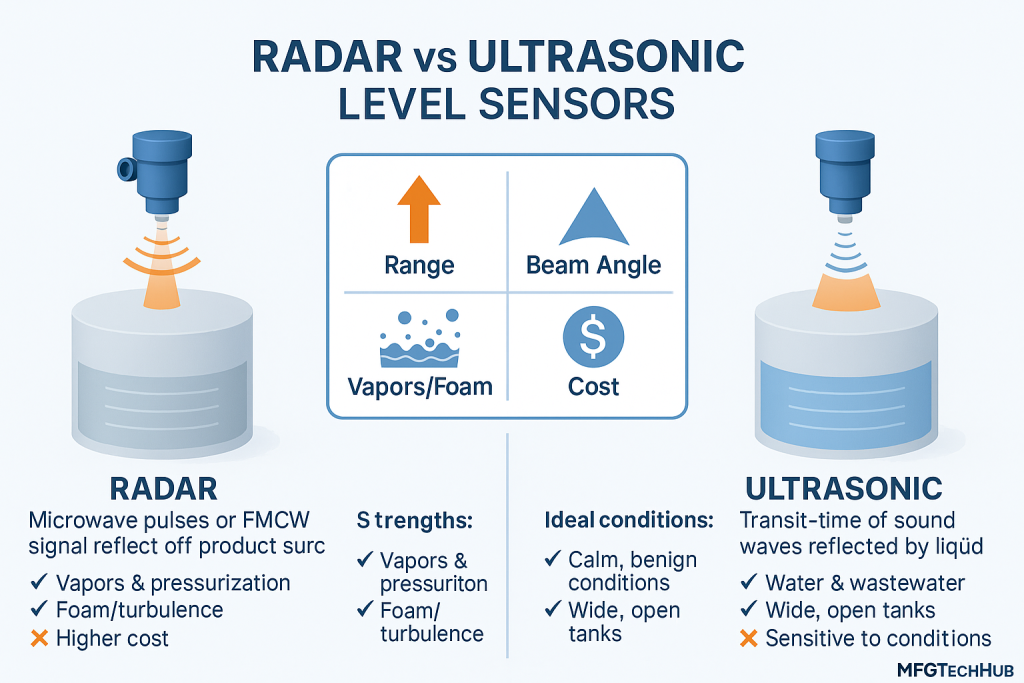Radar and Ultrasonic Level Sensors for Industrial Storage
Why Level Measurement Matters
Accurate level measurement protects product quality, prevents overflows, and enables tight inventory control across tanks, silos, and sumps. In refineries, chemical plants, food & beverage facilities, and water utilities, reliable level data improves safety and reduces downtime. Two proven non-contact technologies dominate modern storage applications: Radar (microwave) level sensors and Ultrasonic level sensors.

What Are Radar and Ultrasonic Level Sensors?
Radar level sensors transmit microwave pulses (or use FMCW—frequency-modulated continuous wave) toward the product surface and measure the time-of-flight of the reflected signal to compute distance and level.
Ultrasonic level sensors emit high-frequency sound waves that reflect off the surface; the echo time converts to distance and level. Both are non-contact, making them ideal for corrosive, sticky, or sanitary services.
- Radar (Pulsed/FMCW): Liquids and bulk solids, handles vapors, pressure, foam better than ultrasonic.
- Ultrasonic: Cost-effective for clean, calm conditions; excellent in water/wastewater and benign chemical storage.
Radar Level Sensors: Principles and Applications
How Radar Level Sensing Works
The transmitter sends microwave energy toward the medium’s surface.
The surface reflects part of the energy back to the antenna.
Time-of-flight (or frequency shift in FMCW) is processed to calculate distance → level.
Practical Example

Advantages
Works in vapor, steam, and pressure; less affected by temperature swings
Narrow beam angle (especially 80 GHz) → fewer false echoes
Handles foam, turbulence, and changing dielectric better than ultrasonic
Suitable for tall tanks and long ranges
Limitations
Higher initial cost than ultrasonic
Antenna selection and mounting geometry are critical
Requires correct dielectric assumptions for optimal performance
Ultrasonic Level Sensors: Principles and Applications
How Ultrasonic Level Sensing Works
The transducer emits an ultrasonic pulse toward the surface.
The surface reflects the sound; the sensor measures echo time.
Distance is calculated from sound velocity; level = tank height − distance.
Practical Example

Advantages
Cost-effective, simple to commission
Non-contact—no wetted parts or clogging risk
Ideal for benign atmospheres and open basins
Limitations
Performance degrades in heavy vapors, vacuum, or high pressure
Echo quality can suffer with foam, turbulence, or angled surfaces
Temperature gradients and acoustic noise can introduce errors
Comparison Table: Radar vs. Ultrasonic (Industrial Storage)
| Feature | Radar Level Sensor | Ultrasonic Level Sensor |
|---|---|---|
| Measurement Principle | Microwave time-of-flight / FMCW | Acoustic time-of-flight |
| Best For | Pressurized/vaporous tanks, foam/turbulence, tall tanks | Open basins, sumps, benign storage, budget-conscious installs |
| Environmental Tolerance | High: steam, vapors, temperature swings | Moderate: affected by vapors, wind, acoustic noise |
| Beam/Footprint | Narrow (esp. 80 GHz) → fewer obstructions | Wider beam → more echo from walls/fixtures |
| Typical Accuracy | High; mm-level on short ranges with FMCW | Good; cm-level typical |
| Cost | Higher | Lower |
| Maintenance | Low; check antenna buildup, verify configuration | Low; keep transducer face clean/dry |
Typical Applications
1) Oil & Gas / Petrochemical
Radar: Floating roof tanks, condensate, LPG bullets (with appropriate process seal)
Ultrasonic: Sumps, separators, produced-water basins
2) Chemical & Pharmaceutical
Radar: Corrosive media with PTFE lens and process seal; vaporous solvents
Ultrasonic: Neutralization pits, polymer tanks without heavy foam
3) Water & Wastewater
Ultrasonic: Wet wells, open channels, clarifiers
Radar: Covered reservoirs, tall storage tanks, digesters with foam
4) Food & Beverage / Bulk Solids
Radar: Syrups, oils, viscous media; high, narrow silos (solids)
Ultrasonic: Non-foaming liquids, CIP rinse tanks
Installation Best Practices
Mounting: Aim beam at the calmest surface; avoid ladders, mixers, and inlets within beam path.
Nozzle/Standpipe: For radar, use short, appropriately sized nozzles; avoid corrugated or narrow standpipes that trap echoes.
Reference Height: Enter accurate tank geometry (zero level, span, height, dead zones).
Compensation: Use built-in temperature compensation (ultrasonic) and dielectric presets (radar) when available.
Validation: Cross-check with a sight glass, dip measurement, or weight/volume transfer during commissioning.
Frequently Asked Questions (FAQ)
Will radar always outperform ultrasonic?
Not always. Radar is superior in vapor, foam, pressure, and long range. Ultrasonic is excellent for open basins and calm, clean tanks at lower cost.
Can I use ultrasonic in a foamy tank?
It depends. Light, intermittent foam may be manageable; persistent heavy foam often favors radar.
Does tank geometry matter?
Yes. Internals, cones, and narrow nozzles create false echoes. Choose narrow-beam radar or reposition the transducer to avoid obstructions.
How do these help with inventory?
Accurate level → reliable volume via strapping tables. Tie to SCADA/MES for real-time inventory and alarms.
Radar and Ultrasonic level sensors both deliver safe, low-maintenance measurement for industrial storage. Choose radar for challenging atmospheres, long ranges, or persistent foam; choose ultrasonic for open tanks and budget-friendly deployments. With proper mounting and configuration, both provide stable data that drives safer operations and tighter inventory control.

 The transmitter sends microwave energy toward the medium’s surface.
The transmitter sends microwave energy toward the medium’s surface. Works in vapor, steam, and pressure; less affected by temperature swings
Works in vapor, steam, and pressure; less affected by temperature swings Higher initial cost than ultrasonic
Higher initial cost than ultrasonic Mounting: Aim beam at the calmest surface; avoid ladders, mixers, and inlets within beam path.
Mounting: Aim beam at the calmest surface; avoid ladders, mixers, and inlets within beam path.